|
By John Pint
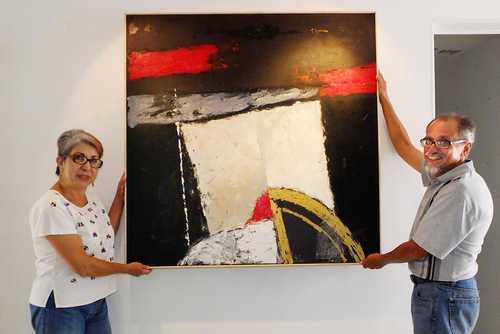 If
you are interested in abstract art and you would like to visit a
gallery in western Mexico, don’t waste your time hunting for one in
downtown Guadalajara. Instead, head for the woods. Yes, amazing though
it may seem, CIANF, Jalisco’s only Center for the Study and Diffusion
of Non-Figurative Art is located inside a very large private home in
the rustic community of Pinar de la Venta, transformed about a year ago
into a gallery and school for abstract art. If
you are interested in abstract art and you would like to visit a
gallery in western Mexico, don’t waste your time hunting for one in
downtown Guadalajara. Instead, head for the woods. Yes, amazing though
it may seem, CIANF, Jalisco’s only Center for the Study and Diffusion
of Non-Figurative Art is located inside a very large private home in
the rustic community of Pinar de la Venta, transformed about a year ago
into a gallery and school for abstract art.
CIANF’s founders are architect José “Pepe” Olivares and his wife
Rosalía. The Center really took off last 5 de Mayo, 2017, when it
hosted an exhibit of archive paintings loaned by Mexico’s most
prestigious institute of abstract art, the Museo de Arte Abstracto
Manuel Felguérez in the city of Zacatecas.
“We had works by famous artists like Filguérez himself, the Catalans
Josep Guinovart and Jordi Boldó, as well as the creator of
Guadalajara’s Los Cubitos, sculptor Fernando González Gortázar,” I was
told by the Olivares. “People flocked to Pinar de la Venta to see these
masterpieces and the TV and newspapers called it a great success.”
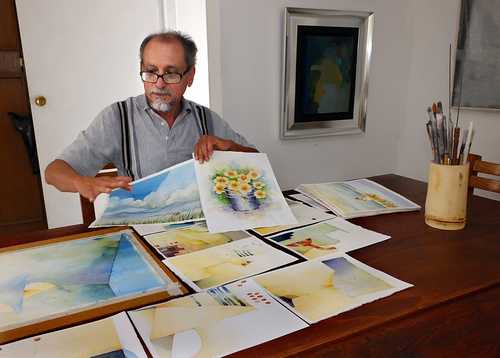 Intrigued,
I popped in twice to observe the art lessons Pepe Olivares gives to
children and adults every week. That’s where I discovered that, like
Picasso, this teacher is just as talented in depicting realism as
abstraction. Commented Olivares, “I often start with drawing or
painting recognizable subjects like flowers or a landscape and after my
students have mastered these basic techniques, we move on to removing
elements until only form and color remain.” Intrigued,
I popped in twice to observe the art lessons Pepe Olivares gives to
children and adults every week. That’s where I discovered that, like
Picasso, this teacher is just as talented in depicting realism as
abstraction. Commented Olivares, “I often start with drawing or
painting recognizable subjects like flowers or a landscape and after my
students have mastered these basic techniques, we move on to removing
elements until only form and color remain.”
I asked one of the adult students, Ana Rosa, how she liked the class.
She said, “for me, this is therapy. I forget my children, I forget all
my troubles and I relax totally. I really look forward—with great
enthusiasm—to coming here every Thursday. I just wish I could do this
twice a week.”
After the class, I sat down with Pepe Olivares and asked him how he
became interested in abstract art. He immediately told me that his
story was “not at all unusual.”
“In my childhood,” Pepe told me, “matches were used a lot, especially
for lighting the stove. Well, I was maybe four years old and my father
showed me a matchbox which had a reproduction of a famous work of art
on its cover. These were called Clásicos de Lujo la Central and my
father gave me a challenge: “I bet you can’t draw this,” he said and I
replied, “Oh yes, I can!” Right there was my first artistic awakening,
you could say.”
I told Pepe that this didn’t seem “usual” to me one bit, but he replied
that he had spoken to many of Jalisco’s artists “and most of them told
me they got going in exactly the same way.”
Pepe’s gusto for drawing stayed with him and he recalls, “when I was in
third grade, they asked us to draw a picture of Miguel Hidalgo. I did
mine on a big sheet of pasteboard and I remember the pride I felt at
succeeding to do this, even though I suspect my drawing must have been
pretty ugly. But with that, I decided that art was what I wanted to do
for the rest of my life. And from then on I drew and drew. This is why
I am involved in giving painting classes to children here, because this
when a vocation can be born.”
Pepe Olivares’ father was practical enough to convince him he should
take up architecture as a career, which he did at the University of
Guadalajara. “Among my teachers,” he says, “were people like the German
architect Hors Hartung, who knew a lot about preHispanic architecture
and also about modern abstract painters and sculptors. His classes were
delicious! I learned a lot from him. We had a class with him called
‘Integración Plástica’ which involved aesthetic games, playing with
volume. We were not trying to represent anything or to copy anything
from nature; it was all about forming pleasing shapes. It was an
exercise in abstraction, working only with forms and colors, and it was
here that I got my introduction to abstract art.”
The CIANF Center not only plans to hold exhibits and workshops, it also
wants to promote research into abstract art present and past, for which
“We are working to set up a library here where people of all ages could
learn about abstract art, do research and experiment with different
techniques. I believe the Olivares would be happy to receive donations
of art books for their burgeoning library.
The art gallery features new exhibits on a regular basis and admission
is free.. To see what they are offering at the moment, check their “CIANF” Facebook
page. If you are interested in taking painting lessons, call
333 616 6242.
How
to get there
Take
Avenida Vallarta west. Eight kilometers past the Periférico you will
see a sign for Pinar de la Venta. Make a U-turn and go into the main
entrance of this community, a big square arch. Immediately turn right
onto Paseo de las Primaveras and drive about 400 meters to house number
98. In front of the gate you will see a telephone pole clearly marked
with a big red 9. Pole nine is an important landmark because house
numbers in Pinar are hopelessly jumbled. Driving time from the
Periférico: about 15 minutes. And here's the Google
Maps link.
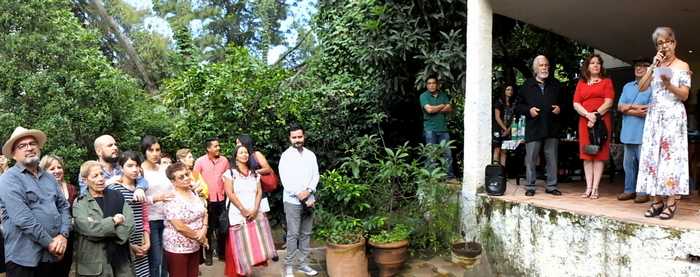
Opening
of a new art exhibit at CIANF in October of 2017.
|

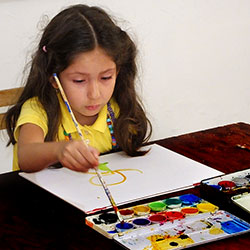
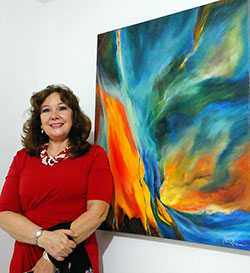
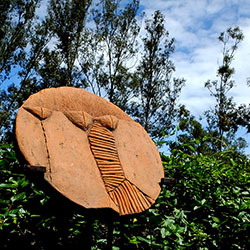
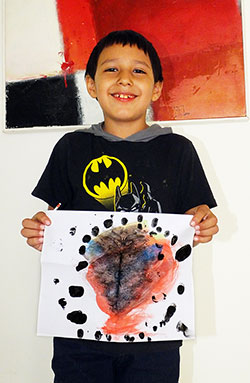

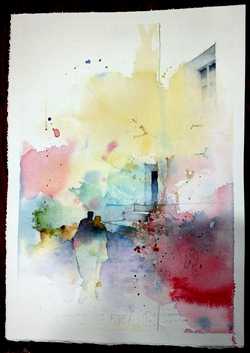
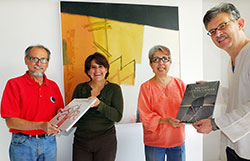

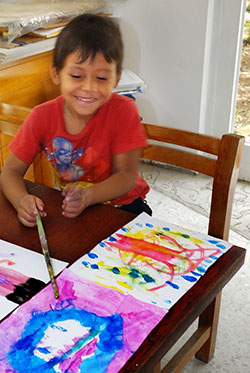
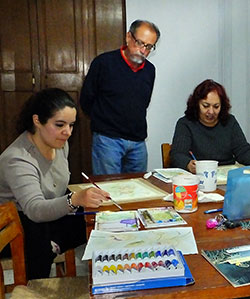
 If
you are interested in abstract art and you would like to visit a
gallery in western Mexico, don’t waste your time hunting for one in
downtown Guadalajara. Instead, head for the woods. Yes, amazing though
it may seem, CIANF, Jalisco’s only Center for the Study and Diffusion
of Non-Figurative Art is located inside a very large private home in
the rustic community of Pinar de la Venta, transformed about a year ago
into a gallery and school for abstract art.
If
you are interested in abstract art and you would like to visit a
gallery in western Mexico, don’t waste your time hunting for one in
downtown Guadalajara. Instead, head for the woods. Yes, amazing though
it may seem, CIANF, Jalisco’s only Center for the Study and Diffusion
of Non-Figurative Art is located inside a very large private home in
the rustic community of Pinar de la Venta, transformed about a year ago
into a gallery and school for abstract art. Intrigued,
I popped in twice to observe the art lessons Pepe Olivares gives to
children and adults every week. That’s where I discovered that, like
Picasso, this teacher is just as talented in depicting realism as
abstraction. Commented Olivares, “I often start with drawing or
painting recognizable subjects like flowers or a landscape and after my
students have mastered these basic techniques, we move on to removing
elements until only form and color remain.”
Intrigued,
I popped in twice to observe the art lessons Pepe Olivares gives to
children and adults every week. That’s where I discovered that, like
Picasso, this teacher is just as talented in depicting realism as
abstraction. Commented Olivares, “I often start with drawing or
painting recognizable subjects like flowers or a landscape and after my
students have mastered these basic techniques, we move on to removing
elements until only form and color remain.”